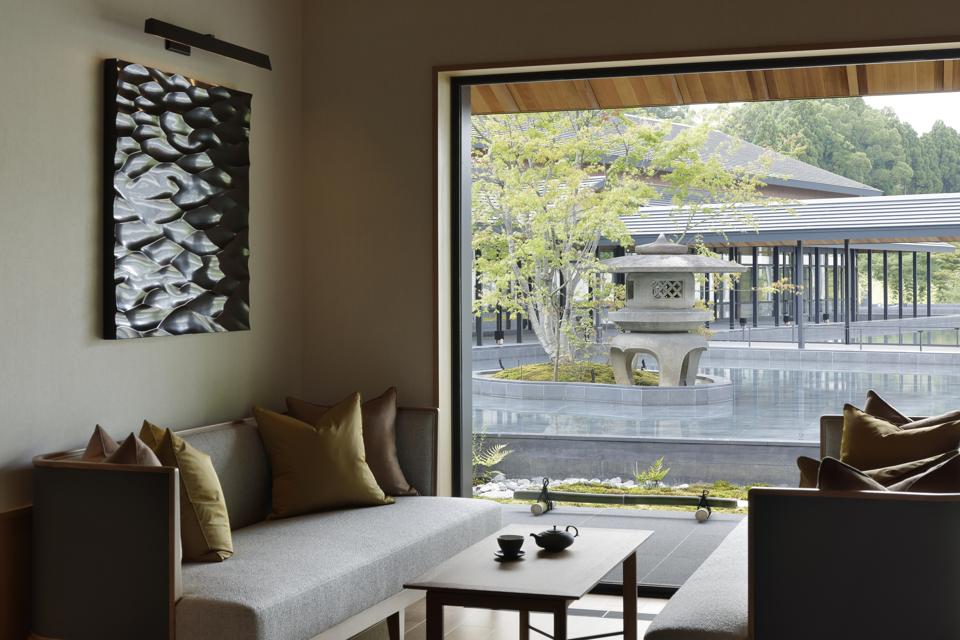Inhale deeply and exhale slowly as you approach the pristine foothills of the Takagamine mountains by the Tenjin River in northern Kyoto, where you will find the splendid ROKU KYOTO. Immerse yourself in serene luxury at this exquisite resort hotel, where chic contemporary style mingles with the rich folkloric and mythological history, imaging the presence of kami (divine spirits) and other supernatural beings (yōkai).
Situated in the mountainous Rakuhoku area in northern Kyoto, on a centuries-old retreat for the imperial family and a hub for artists and artisans, ROKU KYOTO is an ideal choice while exploring a city with an array of major art museums along with more than 1,600 Buddhist temples and 400 Shinto shrines, which emerged over a thousand years (794 to 1868) when Kyoto served as Japan’s imperial capital.
Sense the presence of Hon’ami Kōetsu (1558-1637), a celebrated Japanese painter of the Tokugawa period (also known as the Edo Period) and an innovator in lacquerwork (with raised inlays of metal and shell and bold designs), a calligrapher, a potter, a landscape gardener, maker of Noh masks, and a tea ceremony devotee. The Tokugawa period (or Edo period) was a feudal era from 1603 to 1868 when the Tokugawa clan ruled as shoguns from Edo (modern-day Tokyo), contributing to a flourish in arts and culture.
In 1615, shogun Tokugawa Ieyasu (1543-1616) granted Kōetsu about 74 acres of land in the Takagamine to create what evolved into a widely influential community for artists and artisans. Kōetsu, working alongside his close friend and fellow painter (and furniture designer) Tawaraya Sotatsu (c. 1570-c. 1640), founded Rinpa, a major historical school of Japanese painting characterized by its bold, stylized designs of nature, lavish colors, and use of gold and silver leaf.
Kōetsu’s artistic community of craftsmen was supported by wealthy merchant patrons of the Nichiren Buddhist sect at Takagamine. Affluent area residents and Kyoto aristocratic families supported arts following classical traditions, funding Kōetsu’s production of ceramics, calligraphy, and lacquerware. Nichiren was a monk and philosopher of the Kamakura period (1185–1333), and his teachings form the basis of a unique branch of Japanese Mahāyāna Buddhism based on the Lotus Sūtra, one of the most influential and venerated Buddhist Mahāyāna sūtras.
Preserving that enduring artistic and creative legacy, ROKU KYOTO opened in September 2021 as Hilton’s first property in Kyoto, debuting LXR Hotels & Resorts (one of Hilton’s three luxury brands) footprint in Asia Pacific. The hotel is named for the Japanese word for the foot of a mountain: fumoto (麓), a character which can also be read as roku. It also borrows from the verb suku (漉く), which refers to the traditional process of making paper from wet, pulpy material by spreading it thin and drying. During the Heian Period (794–1185) – Japan’s last division of classical history, named after its capital, Heian-kyō (modern Kyoto) – a trade guild of papermakers made paper along the river bank.
“I am confident that ROKU KYOTO delivers a bespoke experience of Kyoto and fully immerse travelers in the unique charms of the city, attracting both domestic and international travelers,” says Joseph Khairallah, Hilton’s area vice president and head of Japan, Korea and Micronesia.
An oasis within an unspoiled landscape, ROKU KYOTO is located to the south of Shozan Resort Kyoto, built by Nishijin kimono manufacturer and dyer Shozan, whose founder Masao Matsuyama had a vision for a “factory of tourism surrounded by flowers and greenery.” He built Japanese gardens and relocated several historical buildings from around Japan to the property to be enjoyed by the general public, reviving the rich legacy of the region.
In designing the interiors, BLINK Design Group, with studios in Singapore, Bangkok, and Dubai, was deeply inspired by the artistic heritage and in curating art collections from across Japan. Gaze up at high-pitched ceilings in the tea lounge and lobby, evoking the historical architecture of the region. Throughout the grounds, examine artisanal crafts specific to the ancient city of Kyoto, such as urushi (derived from the sap of the urushi tree, Toxicodendron vernicifluum) lacquerware, takezaiku (a traditional Japanese craft encompassing various uses of bamboo, from utilitarian objects to architectural elements and fine art weaving), and traditionally designed copperware.
Indulge in the Roku Spa, with year-round access to a soothing outdoor thermal onsen (pool), fitness center, and spa treatment rooms. Witness the clouds form in the Takagamine mountains, as if overseen by kami, while you float in the velvety embrace of thermal waters rich in minerals such as sulfur, calcium, bicarbonate, and sulfates with restorative healing potential.
Commune with nature as you explore the stone paths, bamboo groves, plum groves, tea houses, and tranquil gardens, where cherry blossoms appear in spring and maple leaves emerge in fall.
Relax in spacious guest rooms replete with Japanese décor, floor to ceiling windows, and breathtaking mountain range vistas.
As the indoor and outdoor environments nourish your soul, feast at TENJIN, featuring unconventional dishes of French cuisine that explore the themes of nature, cuisine, and art, paying homage to Ripna. Each dish conveys a story or celebrates an aspect of Kyoto culture, replete with heirloom vegetables from Takagamine’s medicinal plant gardens and singular plating presentations inspired by Kōetsu’s artistic community, served on tableware created by young ceramic artists from across Japan.
Wine pairings elevate the unrivaled cuisine, drawing out flavors that dance on the palate during a multi-course Chef’s Table dinner led by Chef de Cuisine Akira Taniguchi. The signature show-stopper “Vegetable Garden” showcases fresh herbs cultivated in the herbal garden to adorn Kyoto vegetables.
At ROKU KYOTO, nature and art commune as if guided by kami.

